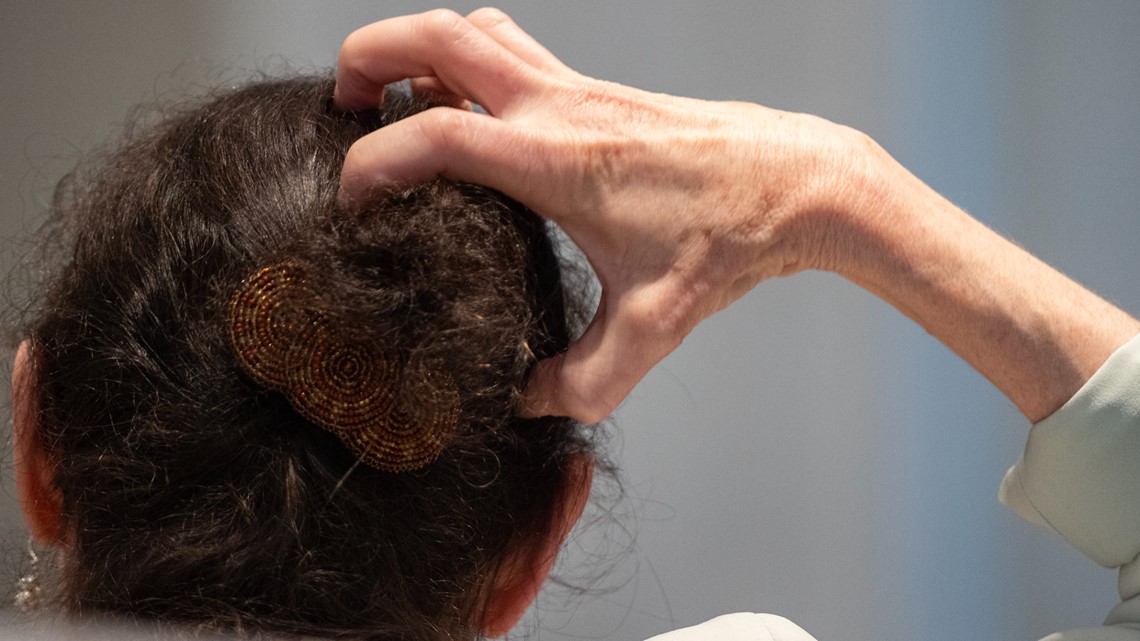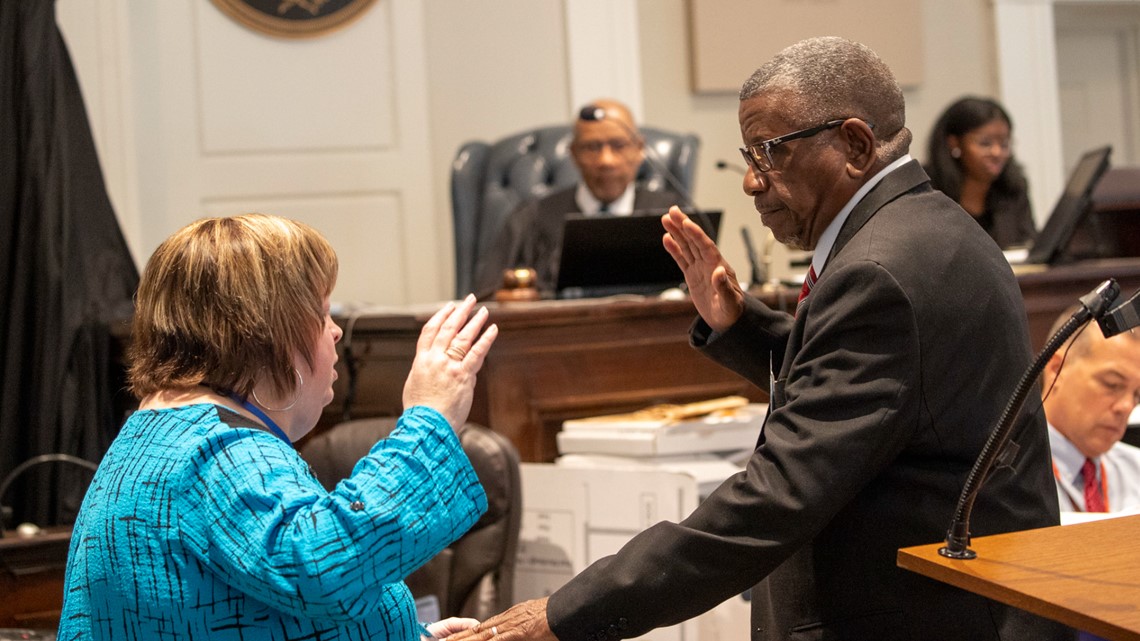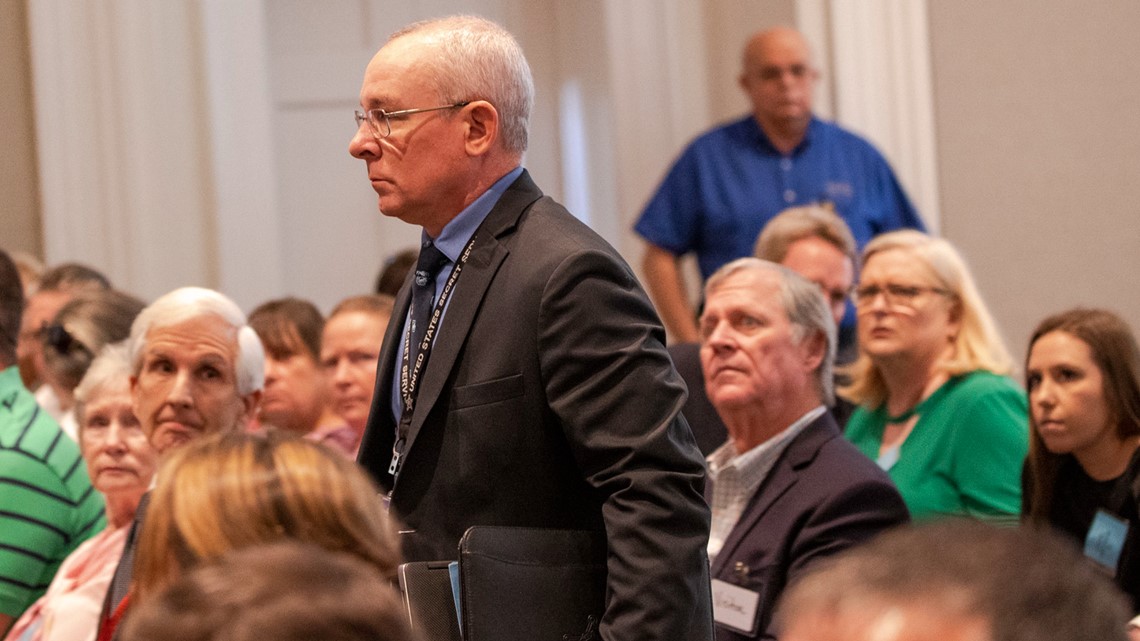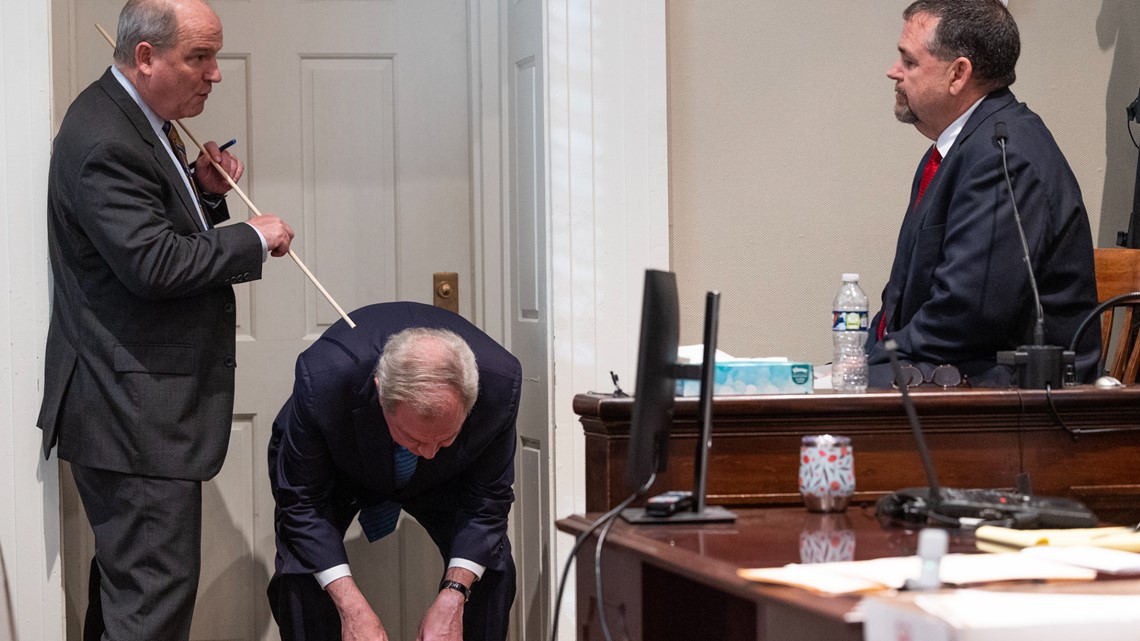WALTERBORO, S.C. — All sides in the double murder trial of Alex Murdaugh have rested their case following the final rebuttal witnesses from the prosecution.
The prosecution and state both declared they were done presenting all witnesses around 4:45 p.m. Tuesday.
Rebuttal witnesses are allowed to be called by the prosecution after the defense wraps up, and are brought in to try and refute claims made by the defense in their presentation.
One of those was pathologist Dr. Ellen Riemer, who had testified earlier in the trial. She contradicted a defense witness from a day earlier who said the gunshot that killed Murduagh's son, Paul, was a close contact wound.
South Carolina Attorney General Alan Wilson stepped in to close the state's case, questioning the final witness himself. Wilson has been sitting on the state's table for most of the trial but had not been directly involved until that moment.
Wednesday, the jury is expected to be taken to Moselle, the Murdaugh family property where the killings took place. Such trips are rare in criminal cases, and the visit was a request by the defense which they feel may help their case. The prosecution objected, saying parts of the property may have changed since the killings nearly two years ago.
Then both sides in the case will present closing arguments, and finally, the jury will get the case.
Murdaugh, 54, is accused of killing his wife Maggie and son Paul at the family's Moselle estate back in June of 2021. Prosecutors say he's the sole person responsible while the defense says the state never seriously looked for any other potential witnesses.
You can find trial updates here every day. Watch live streaming testimony and coverage on wltx.com, on the WLTX+ streaming app on Amazon Fire and Roku TV, and on the News19 WLTX YouTube page.
Tuesday Trial Updates
Ronnie Crosby
Crosby had testified before about his close relationship with Paul. Over the years, Crosby and Paul rode around his property and at Moselle looking for hogs and would carry a rifle while riding. Paul had the 300 Blackout and Crosby would have a 223 or another type of AR.
Crosby said it wasn’t unusual to see hogs in the daytime.
Crosby said Alex had a very good relationship with law enforcement.
Crosby said he and Alex discussed Alex’s story of June 7 on numerous occasions and it was clear to Crosby that Alex checked the bodies before calling 911.
Crosby said when he heard Alex was taking the stand, he watched his testimony and heard for the first time Alex was at the kennels when Alex was on the stand.
Crosby said Alex specifically said to him that no one on the boat had anything to do with the murders but as far as anybody outside, Crosby said they didn’t discuss that because it would be speculation.
Crosby said he had heard of Barrett Bouleware needing money for his illness. Crosby said in June 2018, Barrett was close friends with Alex. Crosby got a call about Barrett being in the Mayo Clinic fighting stage 4 colon cancer and asking Crosby to help him out with finances by buying or selling some real estate holdings. Crosby was asked to buy a lot from Barrett so he would have money for his wife to stay with him during treatment. Crosby said he had a conversation with Alex about Barrett’s financial situation and Alex thought it was a good thing Crosby was doing to help Barrett. During that same time period, in June 2018, Crosby said a $700K insurance check came to PMPED in Barrett’s name that Alex took the same month of Crosby and Alex’s conversation.
Crosby identified a photograph of David Williams. Alex had confused David Owen with David Williams and used that as an excuse to say he was anxious of SLED during his interviews with David Owen.
Williams was involved with Chief Alexander. The two men do not look similar.
Crosby said he worked a case with Alex and observed him getting emotional during closing arguments and was a theatrical presence in the courtroom
CROSS EXAMINATION by Harpootlian
Did you ever ride Moselle with Alex? Crosby said he went hunting and rode an ATV with Alex. Would take a shotgun to hunt doves, not a rifle. Shotgun loaded with birdshot. Dove field is within a few hundred yards of the house at Moselle, and it is bounded by a swamp.
So, hogs could have come out of swamp, and you’re unarmed? Crosby said hunters would shoot at the hog anyway with whatever they had, including birdshot.
You’ve never ridden like Paul and Alex did on June 7, looking at fruit trees and food plots? Crosby said he doesn’t have specific recollection of doing that with Alex.
You’re not saying that they did that without a Blackout? I have no idea what they were doing
They were looking for signs of hogs in the daytime? Aren’t hogs nocturnal? Crosby said he’s shot hogs in the daytime.
What you heard from Alex on June 7…your practice is personal injury, catastrophic injury? Yes
Is it your experience that is a traumatic experience to see a loved one killed and to sit and talk to the remaining spouse, they would get things wrong, times, for instance? They can, but people involved in traumatic experiences try to be very accurate with details.
Typically, you don’t go to the crime scene immediately…you’re seeing them days or weeks later and its more conducive to be more accurate? Typically, Highway Patrol will interview immediately and have written statements from witnesses.
Have you had to come out of pocket to pay Alex’s stolen money? Crosby said he can’t say how much, but yes
Crosby said he had extreme anger about Alex as to what he did to him, his law firm, and to Alex’s family and that he had to get past that – and has.
You think Alex did it? I don’t have the evidence you have
Alex was callous and deceitful in the way he lied? Crosby said he came to the scene of the murders to support Alex and loved Paul. He said he thought he knew who Alex was but doesn’t think so now. It was hard to walk around with anger and he had.
Crosby said he was unaware Alex had a drug problem and if he had known, he would have tried to help him.
Crosby said Alex was theatrical and could become emotional. Johnny Parker is exact opposite. No one in the firm was at Alex’s level of theatrics.
Harpootlian asked, this Bouleware guy, how much did Alex steal? $750K when Bouleware was alive, and another $250K after he died. Crosby said he has paid the Bouleware estate back for what Alex stole.
Crosby said he has no feelings about Alex anymore. It was bad in the fall of 2021, Crosby said. There is not forgiveness, just no feelings about him.
REDIRECT
You’ve known Alex since late 1990s and he still looked you in the eyes and lied to you? He looked me in the eye and lied to me.
Harpootlian asked Crosby, with what you’ve gone through, what is the issue you have with Harpootlian? Crosby said he took an oath to tell the truth and lawyers have oaths and obligations to the court, are bound by ethics rules, and Crosby said he takes that seriously and that’s what he took issue with. Because Harpootlian cannot impugn his integrity on the stand.
Crosby said would take a long rifle to shoot hogs.
Paul’s favorite gun was a 300 Blackout.
RE-CROSS
Is the 300 in evidence Paul’s favorite? Yes
Dr. Ellen Riemer
Waters showed Riemer images from her autopsies of Paul and Maggie. She was asked to do autopsies by Colleton County Coroner.
Skin tags, Riemer said, you look at and take everything into context. Tags don’t tell the direction of wounds going into soft tissue. Riemer identifies photos entered by the defense and they are Maggie’s photos.
The defense’s forensic expert Dr. Jonathan Eisenstat, said Maggie’s wound was from top of head down. Riemer went through her explanation of her findings and why they differ from defense’s pathologist.
The abrasion on the left shoulder and left side of face and left temporal lobe of the brain could happen only as an entrance wound. The fraction along the skull supported Riemer’s opinion that it was an entrance wound. She performed the autopsy and can understand looking at photos and coming to a different conclusion if the other person didn’t do the autopsy or observe the body.
Tears of the skin, Riemer says, in the very soft area where there’s a lot of fat, you can get points to go in different directions. It was not worth observing skin tags, tags can support an opinion but cannot determine path of a wound.
Riemer said she physically observed the wound to Maggie’s head.


Paul’s wounds were contact wounds, according to the defense. Riemer said she didn’t think it necessary to point out everything during her initial testimony. She agrees with the book when there is a contact wound to the head. Bur in this case, of it were a contact wound to the head, there would have been more damage, Paul’s eyes would have been displaced -- but his face was intact. He wouldn’t have had a face left in a contact wound. The damage would have been much worse with a contact wound. His forehead was still there. What we have is not consistent with a contact wound, Riemer said.
Paul’s face still has skin, arms are in same place.
In her 20 years and seeing contact shotgun wounds to the head, he would have had tears to the skin, his eyes would have been out of the skull.
About shaving the top of the head -- Riemer said there would have not been soot on the skull. The wounds to shoulder have all features of entrance wounds.
The oblong wound to the shoulder is because it came in at an angle, grazing the top of the shoulder. Eisenstat said the pellets were going down, Riemer said if he thinks it is an exit wound, that’s what he’d say. In the exit wounds on Paul’s chest, the pellets are going to keep going. On the edge of the wound is the styrofoam packing material from the wadding and it would not have been deposited there on an exit wound. Riemer said another feature -- coming into the left side of the cheek are abrasions, not the classic petal opening pattern of pellets and wadding. The abrasions are consistent with an entry wound -- the pellets went up through left cheek and out through the top of the head. If the wound was downward, the head would have had much more damage.
Riemer said if you look at the wounds logically, the second shot was a wound that went through the shoulder and through the head. No way it was a contact wound to the head.
Riemer said she disagrees with Eisenstat’s conclusions about Maggie’s final wounds.
CROSS EXAMINATION by Harpootlian
You took pictures, made notes that you converted into a report that someone can look at and go over and disagree with? Riemer said the notes are not meant to be completely accurate and are a guide for a final report. Her notes should be in the file. The notes are for her and an aid for the pathologist and her work product, not for public view. She reviewed her report, not her notes for her testimony in court.
The muzzle of shotgun about 3 feet away? Right
You are familiar with the book, gas comes out with the shotgun blast, blowback comes out as pellets are extracted from the barrel. The book says as pellets come out, the container opens, and pellets come out in a pattern that expands over distance. Riemer said that’s what we have here – cluster at the shoulder and spreading out from there to head.
Is this series of shots from the book depicting a contact wound? Yes
Show me where the contact is? At the front. It is a theoretical representation. It is a book showing a classic contact wound.
Your testimony is the barrel is 3 feet away from Paul’s shoulder? Could be because there is no stippling at the shoulder. The pellets are beginning to separate.
At two feet is there any gas left? She cannot say yes or no -- because she used practical reasoning and logic, not a book. There would have been some gas but not the amount in a contact wound.
Riemer identifies a photo from her autopsy. Harpootlian asks what are we looking at? Riemer said it is an entrance shotgun wound to the left shoulder area on Paul.
There is packing material? There is foam frequently present in the wadding along with the pellets and helps keep them together.
You indicated you saw packing material? Some of the packing material deposited on the skin. There is some of the white packing material on the skin. She said she didn’t mention it in the autopsy report, but it reinforced her conclusion about her trajectory analysis.
Harpootlian asked if the packing material was important? It wasn’t in report or notes because it wasn’t important to her because of her past autopsy experience. She didn’t remove any of the material for further analysis.
The shot is much wider that the entrance wound to Paul’s cheek? Yes, it is much larger. Riemer said in this case, the shot came in at an angle perpendicular to his body and would have nothing to do with the spreading of the shot.
Harpootlian: we have pellets coming in at one angle? Riemer said the wound track is left to right and some pellets there


How many pellets were in shoulder? Riemer collected a sampling and took x-rays without brain and head.
Did you take x-rays of the brain? No, didn’t take x-rays of brain. Hindsight is 20-20 but Riemer observed a directional wound and was comfortable with her conclusion.
How many cases have you autopsied where brain exploded, but it was not a suicide? Riemer said she has done few. Contact shotgun wounds are suicides and usually under the chin, in the mouth.
In those cases, brain came out of the cranium? No
An x-ray of the shoulder shows pellets remaining in the area and a disruption of skin and bone and more pellet spread closer to the neck, the trachea, not into the chest.
Another x-ray shows the top of the left shoulder and a number of pellets lodged there.
A third x-ray shows pellets in the head, the brain is not in the cranial cavity but pellets are in the right side of the head. Riemer counts three pellets on the right side of the head. She doesn’t know how many pellets are in the shot. She didn’t count the pellets in Paul’s body.
Harpootlian asks if there were 70 or 75 pellets in shoulder, head, and neck, and 135-165 pellets in a typical shot, there are 40 that passed through? Riemer says she is not comfortable answering that question, she is a physician and an expert in examining a human body and determining manner of death.
Harpootlian asks if after the pellets go through the shoulder and hit bone, if they go through the neck, do they hit bone again? Not much bone in the neck.
When talking about Maggie and a shot that raised her skull and intercranial pressure… Riemer said she didn’t say half the load went through the body, but the brain was surprisingly intact.
The shot was from 2-3 feet away would not go through the skull? Riemer said energy from the ammunition propelling in that direction, you can call it gas.
The book said gas? The kind of gas to cause the head to explode… according to the book? Riemer said the book is describing a contact wound. She says there is energy coming from below, the shattering of the skull is still intact. She didn’t shave the head because she was confident it was an exit wound.
If you shaved the head, you might have found stippling? Riemer said GSR could deposit within a few feet and doesn’t indicate a contact wound.
There was contact though the jawbone? Riemer said it didn’t contact the jawbone
Pellets in left shoulder went down instead of up? There could be some directionality but Riemer could tell from totality of information from autopsy and was confident of direction of the wound path.
How many pellets went through brain? Didn’t x-ray. Examined the body and made determination from those observations.
You indicated there was enough of the skull there to determine what happened? (Jury is shown autopsy photo) What did you look at to make your determination? The totality of the findings told Riemer the head wound was an exit wound and did not further investigation to disprove her findings because she was confident of her conclusion.
Harpootlian asked if Riemer had an autopsy that was a contact wound that wasn’t a suicide? Cannot remember but a contact wound but the features of the body would remain the same. There would be more damage done to the skull if Paul’s wound had been a contact wound.
Did you discuss findings with Dr. Kinsley? Riemer said she met with him once. What he had to say, he was responsible for the crime scene, she was not a blood spatter expert.
You didn’t put packing material info in report? Yes
Certain things you didn’t do because it wouldn’t be helpful to you? Correct
The shotgun wound to shoulder is larger because of the angle? The defect to the shoulder is wider because it is coming across at an angle, didn’t seem odd to her. She says she is not a ballistics expert. Doesn’t need to be a ballistics expert to know directionality in a body.
Why no shot in the cheek if the shot is expanding? Riemer believes it is consistent with an entrance wound and wadding passing through the body.
X-rays were consistent with your opinion? Yes
On Maggie’s wounds, tags are not determinative? Riemer says the tags are not reliable.
One shot going up, one going down? Yes
REDIRECT
You have performed over 5,500 autopsies? Yes
You rely on practical operations by observing the bodies? Yes
Thomas “TC” Smalls
Smalls is the retired sheriff of Hampton County, retiring Dec. 31, 2022. Knows Alex and never had a conversation with him about putting blue lights in a personal vehicle. That’s not something that was done. He hadn’t heard anything about it until Alex’s testimony.
Alex approach you about threats in the boat case? No, never


CROSS EXAMINATION by Griffin
Alex was an assistant solicitor? Smalls said he knew Alex worked with his father in Hampton County.
Were you aware of Alex trying cases without his father? No
Were you aware of Alex was issued a solicitor’s badge? No
Alex said he had been given permission to have a blue light, you said you did not? Correct
Did Anthony Russell give him permission? Russell was a captain under Smalls’ administration and Chauncy Sullivan was a lieutenant.
Did you know they were close with Alex and lights were installed by Eddie Gibson? No. Smalls said Eddie didn’t put lights in vehicles during his administration.
Paul McManigal
Sergeant with the Charleston County Sheriff’s Office and testified before about redacting Alex’s phone records to remove any attorney-client discussions. He is a cell phone forensics expert, assigned to US Secret Service where he got his training.
McManigal was present when there was raise-to-wake on the iPhone testimony. The raise-to-wake function makes it easier for the user to unlock a phone with face ID or to read messages and notifications. The screen will turn on when phone is gently picked up.
McManigal said when phone is picked up aggressively, the screen will not wake. An accelerometer in the phone records motion and then the iPhone will turn on; if picked up aggressively, it will not turn on as a battery saving feature.
McManigal tested an iPhone similar to Maggie’s using various motions and throws it to determine when phone would turn on. He said he picked up phone, shook it, threw it, threw it like a Frisbee, knocked it off the desk. It depended how the accelerometer recorded the motion as to when the screen turned on. McManigal said he determined, when thrown like a Frisbee, the phone would not turn on. It would turn on if shaken.
CROSS EXAMINATION by Phillip Barber
McManigal did not record his testing, it never crossed his mind to video record his testing.
If you would throw a phone out of a moving vehicle, you would need to pick it up? Yes, but it would depend on how you picked it up.
Do you have phone with you? No
Are you aware of the position of the phone when found? Screen up
If you pick up the phone, will the screen come on? If you pick it up gently, yes; if you pick it up aggressively it would not.
If you had recorded data, you would have had to produce it? Yes, but it didn’t come to mind to record the data
Did you make an attempt to find raise-to-wake data? McManigal said he attempted to do so, couldn’t find any.
Have you done this before? Expert testimony was about data within a phone, not physical phone
Are you an engineer? No
Trained in extracting data? Yes
So you have no expertise in engineering? No
You have no more knowledge about how the iPhone works than anyone else here? McManigal says he has no engineering background but he knows how the phone works better than some in the courtroom.


The only thing that detects motion in the iPhone is the accelerometer? Yes
You sat in your office and tossed the phone around and didn’t record test and now setting here testifying how the phone detects motion? Yes
You haven’t said anything that couldn’t be found on Google? McManigal said he knows how the phones work
REDIRECT
What was shown in earlier testimony was a gently tossed phone -- and you did aggressive tosses? Yes
And throwing like a frisbee didn’t cause the raise-to-wake feature on the phone to come on? Correct
McManigal said he doesn’t k now how the accelerometer works, but it doesn’t preclude knowledge of how the overall phone works.
RE-CROSS
How many times do you need to do the experiment for it to become statistically reliable? More than 10
You know about statistically reliability and did you do that here? No
Mark Ball
Ball was back in response to defense case. Prior to murders, did Alex have any issues with SLED? No
How was relationship with law? Ball said it was a good relationship
Did he know Alex put blue lights in his personal vehicle? Not in the one that has been seized, he’s only had that Suburban about six months. Cannot remember exact date blue lights were installed in his prior vehicle.
Ever shoot hogs? A bunch of them
Can you do that in daytime? Ball said two weeks about shot four around 4:30, they come out any time. They root and that’s the problem
Ever know Alex to talk about target shooting with a pistol? No
Paul’s weapon of choice? That’s what the 300s were for. Ball said he wasn’t a 300 fan
Ball said he talked to Alex the night of June 7 and on other occasions, sometimes in detail. Everybody was trying to figure it out. Ball said Alex told him he went to Maggie and then to Paul and rolled Paul over. Ball said the second time, Alex said he went to Paul first and then Maggie. But Alex definitely said he checked on them before calling 911. Last Thursday was the first time Ball found out Alex was at the kennels. Ball has known him 34 years.
Ball said Alex was able to effortlessly lie to his face. A lot of things Ball said he was told just wasn’t there – the reason for the blue lights, the reasons for taking money


CROSS EXAMINATION by Jim Griffin
After Labor Day weekend when Alex was confronted? He was confronted before about stealing money
You talked to him again after that? Ball said he talked to him when Alex was going to Altanta for detox. He got a call that showed up as coming from John Marvin but was really Alex. He hasn’t spoken to Alex since Labor Day 2021.
No opportunity to talk to him? No
No expectation he would come to you about being in a video? Not since September
About Alex’s distrust with SLED? Never heard about mistrust of SLED or anything else from Alex
Never heard him say Paul was unrightfully charged in boat case? On that case Ball knew Alex was upset, but did not know if it was against law enforcement. Alex thought it was a defensible case against Paul about who was driving the boat.
You were informed in Spring 2021, SLED was investigating Alex for obstruction in the boat case? Ball didn’t know and didn’t know if Alex knew
Were you aware Alex and his father sat in on prosecution of Chief Alexander? Ball knew Alex was there but didn’t know details of the case.
Alexander was prosecuted after SLED investigated? Yes. Chief Alexander was found not guilty by a jury.
Colleton County recused themselves because of Alex’s close relationship with the department? Ball said he didn’t know reason but thought that might be the case
Alex had good relationships with other law enforcement agencies? Yes
Hogs become nocturnal when there’s pressure put on them? Depends on things, swamp is up right now, so they’re on the hill
The pressure is hunting pressure? Ball knew Paul hunted hogs but unaware of any pressure Paul put on hogs.
Looking at Moselle from drone, south is the dove field and behind the residence is a swamp and goes south; across the street from the house is duck pond and timber? Hogs can be anywhere
In June, its warm. Hogs stay in swamp? Ball hasn’t seen that. He’s trapped and shot them. He carries a gun with him all the time.
You understood Maggie and Alex got the 300s for Paul and Buster and they had thermal scopes and Paul got a replacement for his missing 300? Ball has heard that.
Buster’s gun is in the courtroom? Ball saw it taken from the house
About Alex emoting during trial, he’s emotional person? Ball thinks he is. Everybody gets emotional.
Recall reading on June 8 statement released through Colleton County Sheriff’s office about no danger to the public? Ball said it concerned him because he was at Moselle on June 7. He said he got on the phone with Sheriff Smalls and asked about it. Later a lieutenant explained to Ball they had no credible threat to anyone else. Ball said he still had questions and last thing he wanted was for someone to come to the firm and shoot up the place.
REDIRECT
You were asked about Colleton recusing themselves, are aware they still helped on the case? Ball knew they were out there because a deputy called Ball about location of Alex’s truck
After the first few months, the solicitor’s office was still on the investigation? Ball said yes. Stone recused himself in August.
That is the same office Alex had a badge with? Yes
RE-CROSS
Sheriff office does investigations, the solicitor does prosecuting? Yes
Dr. Kenny Kinsey
Kinsey, an investigator with the Orangeburg County Sheriff’s Office was recalled to the stand to go over his crime scene reconstruction of Moselle.
Kinsey has reviewed the case and been to the scene and recognizes the satellite map of the Moselle property.
Attorney General Alan Wilson asks Kinsey if he saw or heard defense testimony on the height of the shooter. Kinsey said he did.
The green lines on a photo introduced by defense’s crime scene expert Mike Sutton show a predictive trajectory for possible shooters and Sutton pointing a pump action shotgun into the feed room. Sutton said he used trigonometry to calculate the height of the shooter.
Kinsey said Sutton had best intentions, but calculations were wrong.
Kinsey identifies photos of quail pens in the kennel area and a photo of a bullet defect on the side of a quail pen. Kinsey said the original investigator, SLED Agent Melinda Worley gave two angles of possible trajectories in the cardboard siding.
Kinsey said direction and angle of impact could be determined from the holes. He is confident of direction determined by SLED, no confidence in defense’s determination of the angle of impact.
Kinsey says two things could influence angle of impact – internal action of the firearm or if the bullet hit something before hitting the cardboard. He demonstrates how an angle can be influenced, using a dowel for visual reference. Kinsey said he put defects in a cardboard box to show what he meant. The dowel inserted in the defect will help determine direction but is not the end-all, be-all. Kinsey said Sutton determined angles by using a protractor and a confident bullet defect, you can use a rod on a fixed object to get a direction. Sutton referred to the defect as a bullet wipe and said the bullet struck at a wobbly way.
Kinsey said the dowel is not caliber-specific and an investigator tries to pick a dowel to fit most closely to the hole. Upon inserting a rod, Kinsey said, unintentional damage can be done by inserting and taking out the rod in the defect hole.
Once a crime scene person has their measurements, one doesn’t know what angle the investigator took to remove the rod from the defect. Take it out to the left or right, up or down, and it affects the angle appearance of the bullet defect in cardboard.
Kinsey said Sutton said the angle was between 1 and 3 degrees, going up, right to left. Kinsey said the direction was correct, but he is not confident in Sutton’s angle of the bullet entry. In the doghouse, Kinsey puts more confidence in the angles because the surface is wood rather than cardboard. The doghouse is ½ to ¾ inches thick, the quail pen is weathered corrugated cardboard.
Kinsey identifies the defense’s animated drawings of possible shooters and the angle of the shots. There are three angles in the photo, two are from the quail pen, one from the dog pen.
How did defense come to determine height of the shooters? Kinsey said the defense plugged in different heights and had to place shooters on the line showing the angles. The defense determined the angle was based on the green static lines and shooters were placed along the lines due to location of spent cartridge cases. Shooters would be somewhere along the green sight line. Kinsey said shooters were placed on the line in relation to the cartridge positions.
Kinsey said there are variables to consider -- a static crime scene, confidence on angle of impact, the inability to test-fire the weapon with the same ammunition, guns don’t always throw spent cartridges in the same direction, cartridge casings are to the left of the animated shooters and therefore the shooters are not always on the static green line. If it is a left-handed AR, no one has determined it is or not.
Assume the angles are correct, why is defense theory of height still off? Weapon position, distance, and height need to be considered.
Can a person be on their knee get the same angle as a standing person? Absolutely. Kinsey demonstrated how that could happen. It would depend on distance.
From what you observed, was Maggie moving? Kinsey believes victim and suspect were both moving. Cartridge casings are in different locations and different angles and positions. Cartridges are moving as they’re ejected from the gun.
In her final resting position, Maggie’s head was pointing toward Paul, back toward the feed room.
Wilson asked Kinsey: the defense’s expert witness said the shooter couldn’t have been 6’4” like Alex? That is a flawed opinion.
Kinsey describes an image of the shot in the feed room where the shot went through the window, a pink string is from the hole in the window to a pine tree, and Sutton with a pump action gun in the feed room. Defense’s theory is Sutton is showing the angle wouldn’t match if a tall person was shooting into the feed room
Another photo has Sutton holding the shotgun lower and parallel to the floor, trying to follow the angle of the string from the window to the tree – to determine trajectory. Kinsey said with a rifle you’re dealing with a single projectile; with a shot shell you’re dealing with 9 or 10 shots packed into a shell. When the pellets are fired, they start to spread in a cone, left and right, the more distance, the further the spread. You cannot get a true trajectory or true angle with a single pellet, Kinsey says.
Kinsey says a 6’4” suspect cannot be excluded from that angle. He disagrees wholeheartedly with defense’s conclusions. Unknowns are how the weapon was held, the proportions of the shooter’s body.
Could the shooter have been running laterally or toward Maggie? Could be, but that’s an unknown
There is no way to definitively exclude a 6’4” suspect from being the shooter? No. Defense relying on math and absolutes and sometimes in crime scene investigation there are no absolutes.
Have you observed a contact would to the head with a shotgun? Many times – about 3 dozen
Contact wound to the back of the head? About one dozen
Describe the trauma – specifically to the face: Kinsey says the result is similar in contact wounds: the forehead and facial features have gone away. They have been shredded. A pathologist can put one back together but from the teeth up the person has gone away.
Kinsey describes Paul’s autopsy photo where his face and forehead do not show the same impact of a contact wound to the head.
Kinsey said in a contact wound, facial features are gone, if the eyes don’t pop out, the eyes would be along the cheeks and pellet exiting the body would be found in skin flaps.
Wilson asks are the wounds on Paul consistent with a contact wound? Not in Kinsey’s opinion.
Did you observe Palmbach’s testimony? Kinsey said he did. Palmbach came up with conclusions on how Paul was shot – a contact shot to the back of the head, the shooter passed Paul and shot him from behind in the feed room, or there were two shooters.
Kinsey identifies a photo of Palmbach with his had cupped inside the feed room. Kinsey walks through the defense theory as Kinsey believes Palmbach meant it.
Wilson takes the shotgun in evidence and points the gun at Kinsey and Kinsey directs him to walk through what he believes to be Palmbach’s scenario – he shoots first Paul in the side, passes Paul in the doorway and shoots him again in the head from behind. Kinsey thinks this theory is preposterous because the idea the velocity of the gun and the steel pellets will go back at 180 degrees and embed in a doorframe is preposterous. Kinsey says there is no defect to the exterior paneling at the bottom, the shot had to go somewhere. The door has a clean void and there are no cracks, chips in the cement, no deflects on the floor. What was Palmbach referred to as high velocity blowback is in Kinsey’s opinion medium velocity spatter that went up and came back down. Steel is not like blood and tissue in the way it reacts and travels.
Kinsey says there is nothing definite but 8 to 10 percent is blowback, most of the force is coming out of the front of the barrel of the gun.
Wilson asks Kinsey to explain if someone is shooting down, how do pellets get embedded in doorframe above? Kinsey said physics don’t work that way.
What is defense’s theory about blowback to the shooter’s face temporarily stopping and injuring the shooter. Kinsey said the theory was the shooter would be incapacitated and injured by pellets. He doesn’t see any reason to squeeze past a victim to shoot him in the back of the head and – if it did happen that way -- why there were so many pellets inside the feed room.
Kinsey has reviewed the case file and what was crime scene evidence and saw testimony. The tool marks on the spent 300 cartridges next to Maggie and the spent 300 cartridges near the back door at Moselle were similar. Kinsey said according to the firearms expert’s testimony, the casings were loaded into and ejected into the same weapon, and the firearm belonged to the family.
Wilson asked Kinsey: John Marvin said he came back the crime scene on June 8 and began cleaning it. Can Kinsey explain how crime scenes are typically cleaned? Kinsey said private companies are contracted to clean up crime scenes through victims’ advocates departments through the state. Law enforcement cannot legally collect and transport and dispose of body parts and fluids. That is the job of the coroner’s office.
Kinsey’s opinion that a 6’4” shooter cannot be excluded.
Is it right for the defense to say there were two shooters? No
CROSS EXAMINATION by Griffin
Kinsey’s degree is in criminal justice and has had training in firearms, ballistics, and gunshot wounds. He did his doctorate in media influence and law enforcement use of force.
In this case, the State has a pathologist ant Kinsey accessed her work and talked to Riemer. Kinsey and Riemer agreed on the angles of the shots to Paul. Kinsey listened to Eisenstat’s testimony. SLED doesn’t have a pathology department. Eisenstat was chief medical examiner at GBI and it was his opinion the second shot was a shot to the back of the head.
If he is correct, you are incorrect? Yes, but Kinsey believes he is correct.
The book that has been referred to during the trial is not considered by Kinsey to be the bible of gunshot wounds. He says there are better sources out there.
Kinsey said he had differing opinions and Palmbach was an engineer, Kinsey is a crime scene investigator.
Griffin asks Kinsey who took the measurements in the quail pen? Kinsey said SLED agent Worley took the measurements and Kinsey understands that defense’s crime scene investigator Mike Sutton relied solely on Worley’s measurements. Kinsey disagrees to Sutton’s absolute opinions.
Kinsey recognizes the photograph of Worley’s measurements and Kinsey said the angle could be inadvertently altered by unknowns. All the photograph proves for Kinsey is the shooter was moving and Maggie was moving.
Kinsey says he doesn’t know when Worley took the photos, and it wouldn’t matter on the quail pen because it is paper. Kinsey says Worley may have been showing direction or angle of impact when she took the photos.
Kinsey says the shooter and Maggie were moving and at some point, she was near the doghouse.
Kinsey is shown another photo of the inside of the quail pen and a shot going through paper and a fixed wood siding. Kinsey said it only proves Maggie was close to the quail pen and moving. He doesn’t know what else it would prove. Kinsey never disagreed with Sutton’s direction but disagreed with his assumption of the height of the shooter. Kinsey said it was his opinion that Sutton meant only a person of a certain height could have made those shots. And that’s want Kinsey disagrees with.
How tall off the ground is the defect in the quail pen? Kinsey does not recall.
Griffin shows the record of 4’10”. Kinsey said he looked at it but didn’t do measurements, he talked to Worley about her records.


Kinsey is getting paid for 100 hours, roughly used 70-80 hours from work, and working off mutual aid. He joked he’ll be charging more beginning next week.
Kinsey has no disagreement with the angle of the shots near the quail pens. He believes the shot angle could be rising from the quail pen, doesn’t believe it was going downward.
Kinsey said he knew there was a moving victim and a moving shooter, and it was a fluid crime scene.
To determine the angle of the muzzle of the gun, Kinsey would need a concrete point along the line.
Kinsey points out the location of feed room on an image of the kennels. Griffin asks Kinsey if he knew the distance of some of the measurements. Kinsey said he didn’t do some measurements based on the location of shell casings.
About Paul and Kinsey’s analysis – Under your analysis shot was from shoulder up through chin and through head? Kinsey said yes, that was his analysis. He said Paul was near the doorjamb and a void. The angle wouldn’t match if Paul was on the hinged side of the door. Kinsey said Paul had his head down and shoulder near doorframe. The shooter had the shotgun with the end of the barrel within two feet of Paul. Kinsey doesn’t know if shooter is left- or right-handed but the spent shot shell could easily get ejected and end up inside the room.
Under Kinsey’s analysis, Griffin asks if the shot is going up through Paul’s shoulder, chin and back of head? Yes
There were about 150 pellets in the shot? Kinsey said he quit counting and would have to rely on the literature
And 60 or 70 pellets found in the body? Kinsey didn’t count but assumes so
Kinsey recognizes the photo showing spatter with hair, bone, and body fluids. Paul would be about 135 degrees close to the side of the door, Kinsey said one can look at the directionality of the blood.
And 35 or 40 pellets would be coming out of the top of his head, and you found a defect in the door? Yes. There are several defects on the door. Kinsey has a photograph he says he can show Griffin if he wants to see. He tells Griffin, “You zeroed in on one pellet but there are others you can see if you zoom out.” Kinsey said the pellets show a pattern and expansion. Kinsey said the pellet in the door came out of Paul’s body and embedded in the door.
Kinsey said 8 to 10 percent of what’s in front of the gun will come back as back spatter.
Kinsey is shown a photograph of blood spatter where Paul was standing. Kinsey said that is medium velocity spatter on the floor that was probably where Paul’s brain hitting th e cement.
Griffin said Palmbach said it was back spatter coming from the contact wound to the head.
Kinsey understands what Palmbach said, but that’s not what Kinsey believes what happened.
Kinsey doesn’t agree there is a void area on the door because there is no outline of a person or implement. Kinsey sees spatter on the door, if there is a void, there will be no spatter on the door. Kinsey said the fluids were projected upward to the ceiling and that’s why there is blood and hair on the ceiling.
Griffin asks was there was no evidence of someone testing footwear impressions? Kinsey said he didn’t know the process involved on June 7. He can only judge what he himself would do but it would depend on the situation.
Griffin asks Kinsey to identify a photo taken from outside the feed room door. Kinsey said the pock marks outside the feed room door could be from pellets or a pressure washer. Kinsey said he would have to see the concrete elsewhere to check to see how it weathered.
Kinsey said he has worked about 3 dozen shotgun head wounds, about 12 of which were self-inflicted. Some were birdshot but Kinsey cannot remember the caliber of the weapon or ammunition involved. About 12 were contact wounds to the head. Kinsey said some had brains ejected but more often, the face and head goes away.
Kinsey has worked cases where brains have been ejected, both execution and self-inflicted.
Kinsey would describe Paul as an execution but not in the traditional sense. Paul was caught off guard by someone he trusted.
Kinsey says closer you get to the muzzle to the gun, the blowback will increase. Brain matter, blood and bone is possible.
Griffin asks how many times he’s worked a scene where there is a 300 and a shotgun? Logically if you’re going to shoot two people why use two guns? Kinsey said if there were two weapons available and you didn’t put too much thought into it, you’d use whatever was available. Kinsey would prefer to use the shotgun on a moving target, not the rifle. And Kinsey wouldn’t expect a person to survive a single shotgun blast.
Kinsey determined Palmbach put the shooter inside the room. Palmbach never said the two passed, did he? Kinsey believed that’s what Palmbach meant with the void.
REDIRECT
You had a chance to talk with Riemer and listen to Eisenstat and go to the crime scene and observe the area where Maggie and Paul were shot and get a context as to what happened? Yes
Which is more consistent with what happened, in Kinsey’s opinion? Kinsey said Riemer’s is closest. Kinsey disagrees with an angle but doesn’t change his opinion.
Assume the angle of impact are correct, are there other variables that could influence the height of the shooter?
Shooter moving and victim moving and its chaotic? Yes
No wat to know how the gun was shouldered? No way
Wilson asks Kinsey if he knows where the photo was taken? Kinsey has no idea.
Are there anything that stands out? The concrete defects are not uniform, and it tells me nothing.
Check back throughout the day for more information
Wednesday Preview
Testimony is expected to resume at 11 a.m. on Wednesday following the jury visit to Moselle earlier in the morning.
You can find trial updates here every day. Watch live streaming testimony and coverage on wltx.com, on the WLTX+ streaming app on Amazon Fire and Roku TV, and on the News19 WLTX YouTube page.



